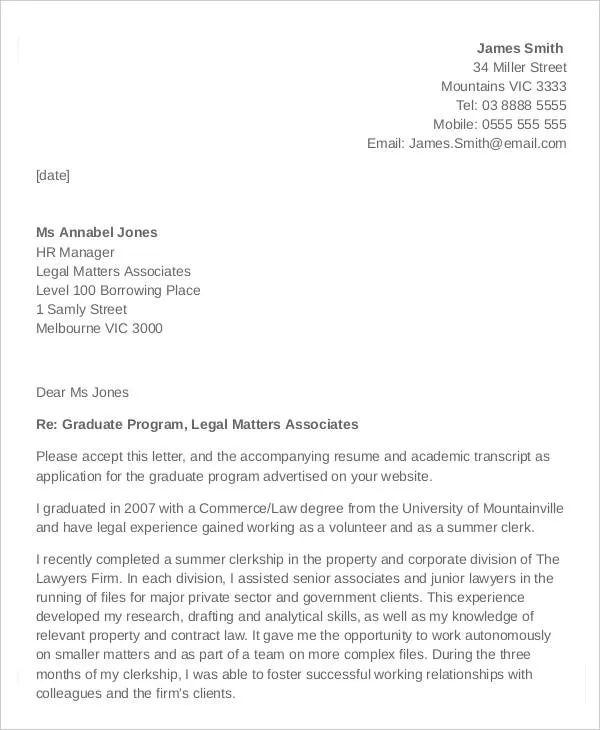What is a Law School Cover Letter
A law school cover letter is a crucial document that accompanies your application to law school. It serves as your personal introduction, allowing you to showcase your personality, experiences, and aspirations beyond what is presented in your resume and academic transcripts. Think of it as your opportunity to make a strong first impression on the admissions committee and to distinguish yourself from other applicants. A well-crafted cover letter can significantly enhance your chances of being accepted into your desired law school. This is your chance to show the admissions committee why you are a good fit for the school and how you will contribute to their community. It’s not just a formality; it’s a strategic tool to tell your story and advocate for your candidacy.
The Purpose of a Cover Letter for Law School
The primary purpose of a law school cover letter is to provide context to your application and to demonstrate your genuine interest in the specific law school. It allows you to explain any discrepancies in your academic record, elaborate on your extracurricular activities, and highlight skills and experiences that make you a strong candidate. Moreover, the cover letter gives you the chance to express your passion for law and your specific reasons for wanting to attend that particular school. By articulating your goals and aspirations, you can show the admissions committee that you have a clear vision for your future and that you are committed to pursuing a legal education. This document is your chance to persuade the admissions committee that you are not just academically qualified, but also a well-rounded individual with a compelling story to tell.
Key Components of a Law School Cover Letter

A compelling law school cover letter consists of several key components, each playing a vital role in presenting your candidacy effectively. These components work together to create a cohesive and persuasive narrative. A well-structured cover letter demonstrates your attention to detail, organizational skills, and ability to communicate clearly. Understanding these components will help you craft a cover letter that stands out and captures the attention of the admissions committee. Ensure each part of your letter is polished and contributes to your overall presentation, enhancing your chances of acceptance.
Header and Contact Information
Your cover letter should begin with a professional header that includes your full name, address, phone number, and email address. This information should be clearly presented and easy to read. Ensure that your email address is professional and appropriate; avoid using nicknames or informal language. The header ensures the admissions committee can easily contact you. It is customary to include the date as well as the recipient’s information: the name of the admissions officer (if known), their title, the law school’s name, and the school’s address. This shows you’ve taken the time to personalize your letter and pay attention to detail, both of which are crucial for a successful application.
Salutation
The salutation should be formal and addressed to the admissions committee or, if possible, to a specific person, such as the admissions officer. Using the recipient’s name shows you’ve done your research and taken a personal approach. A common and safe option is to use “Dear Admissions Committee.” If you know the name of the admissions officer, use “Dear Mr./Ms. [Last Name].” Avoid generic salutations such as “To Whom It May Concern,” as they suggest a lack of effort and personalization. The salutation sets the tone for the rest of your letter, so make sure it is respectful and professional.
Opening Paragraph
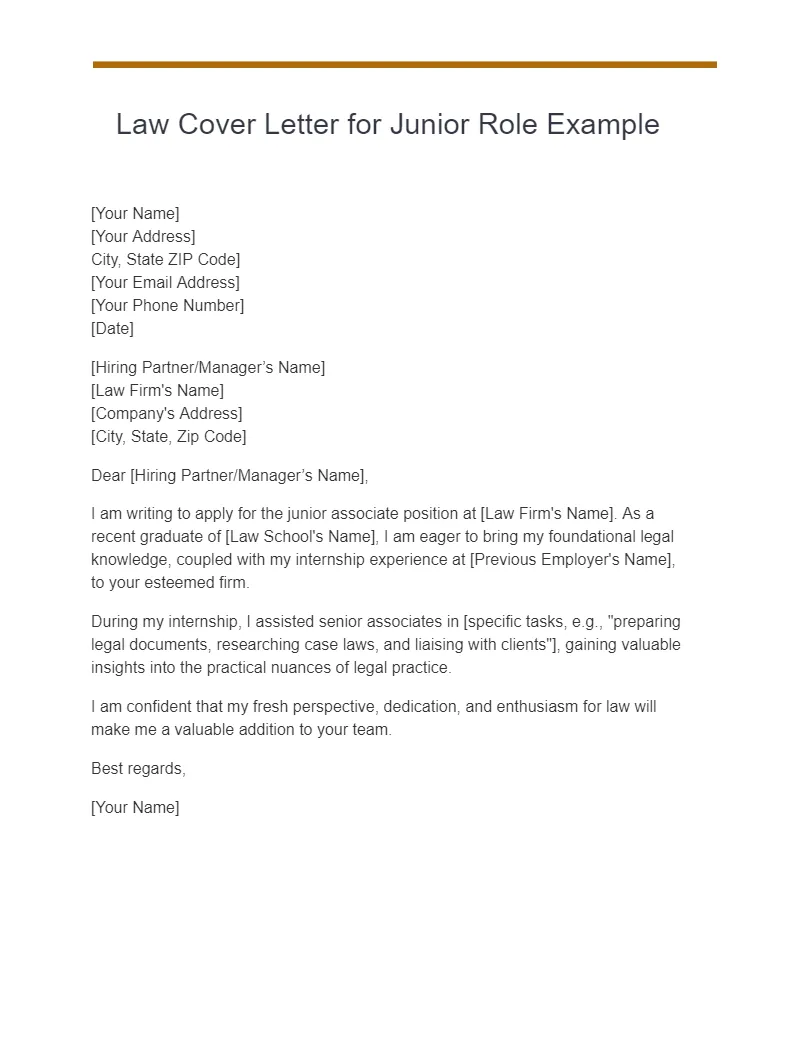
The opening paragraph is your first opportunity to capture the reader’s attention and make a strong first impression. Briefly state your purpose for writing, indicating the law school you are applying to and the position. In the opening, you should briefly mention why you are applying and what you hope to achieve by attending law school. Avoid generic opening lines. Instead, aim for an engaging and compelling introduction that immediately grabs the reader’s attention. Your goal is to show your enthusiasm and highlight your unique qualifications, making them want to read further. Keep it concise and to the point, setting the stage for the rest of your letter.
Body Paragraphs
The body paragraphs are the core of your cover letter. This is where you provide details about your experiences, skills, and qualifications. It is where you highlight what makes you a good candidate. It should also showcase your interest in attending the specific law school. Focus on experiences that have shaped you, such as internships, work experiences, volunteer work, or significant academic achievements. Connect your experiences to the skills and qualities that are essential for success in law, such as critical thinking, research, writing, and communication skills. The body paragraphs should be well-structured, with each paragraph focusing on a specific aspect of your qualifications or experiences. Use clear and concise language, and avoid jargon that the admissions committee may not understand. Demonstrate how your experiences have prepared you for the rigor of law school.
Highlighting Relevant Experiences
Choose experiences that are most relevant to your law school application. This could include internships, research projects, volunteer work, or leadership roles. For each experience, describe your responsibilities and accomplishments, focusing on how you developed skills applicable to law school, such as analytical thinking, problem-solving, and teamwork. Quantify your achievements whenever possible; for example, you might state that you managed a team of five people or increased sales by a certain percentage. Use the STAR method (Situation, Task, Action, Result) to provide context and detail your experiences. Briefly explain the situation, the task you were assigned, the actions you took, and the results you achieved. This structure provides a clear and concise overview of your accomplishments. Show, don’t just tell, the admissions committee about your abilities.
Showcasing Skills and Qualities
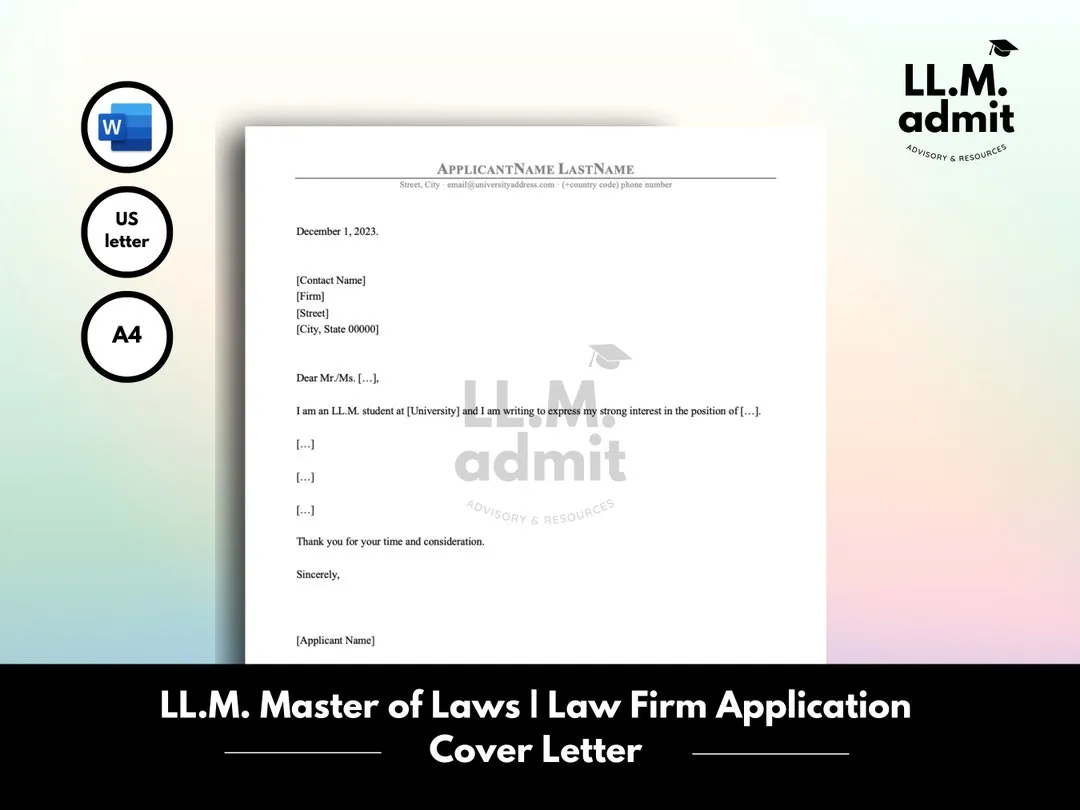
Identify the skills and qualities that are most important for law school success. Highlight how your experiences demonstrate these qualities. These might include analytical thinking, critical reasoning, strong writing abilities, the ability to work independently, and the capacity to work well in teams. Provide specific examples to support your claims. If you possess exceptional writing skills, show it by the way you write your cover letter. If you have excellent communication skills, mention instances where you effectively conveyed complex information. Make sure to align your skills and qualities with the requirements of the law school. Focus on abilities that contribute to law school success and that demonstrate your potential as a future lawyer. The admissions committee wants to see how you embody these qualities.
Demonstrating Interest in the School
Show that you have researched the law school and understand its mission, values, and academic offerings. Demonstrate your interest by mentioning specific programs, faculty members, or initiatives that resonate with your interests and goals. Explain why this particular law school is the right fit for you, and how you see yourself contributing to the school’s community. Mention any specific professors whose research interests you. Discuss any unique aspects of the school, such as clinics, centers, or student organizations, that you are eager to participate in. Tailoring your letter to each school shows that you have taken the time to understand the institution and that you have a genuine desire to attend.
Closing Paragraph
The closing paragraph is where you express your gratitude for the admissions committee’s time and consideration. Reiterate your strong interest in attending the law school and emphasize your eagerness to contribute to the school community. Summarize your key qualifications and restate your enthusiasm. Avoid being repetitive or using clichés. Express your willingness to answer any further questions and include a professional closing, such as “Sincerely” or “Respectfully.” End your letter on a positive and confident note, reinforcing the impression you want to leave with the admissions committee. This final paragraph reinforces your commitment to attending their school.
Formatting and Proofreading Tips
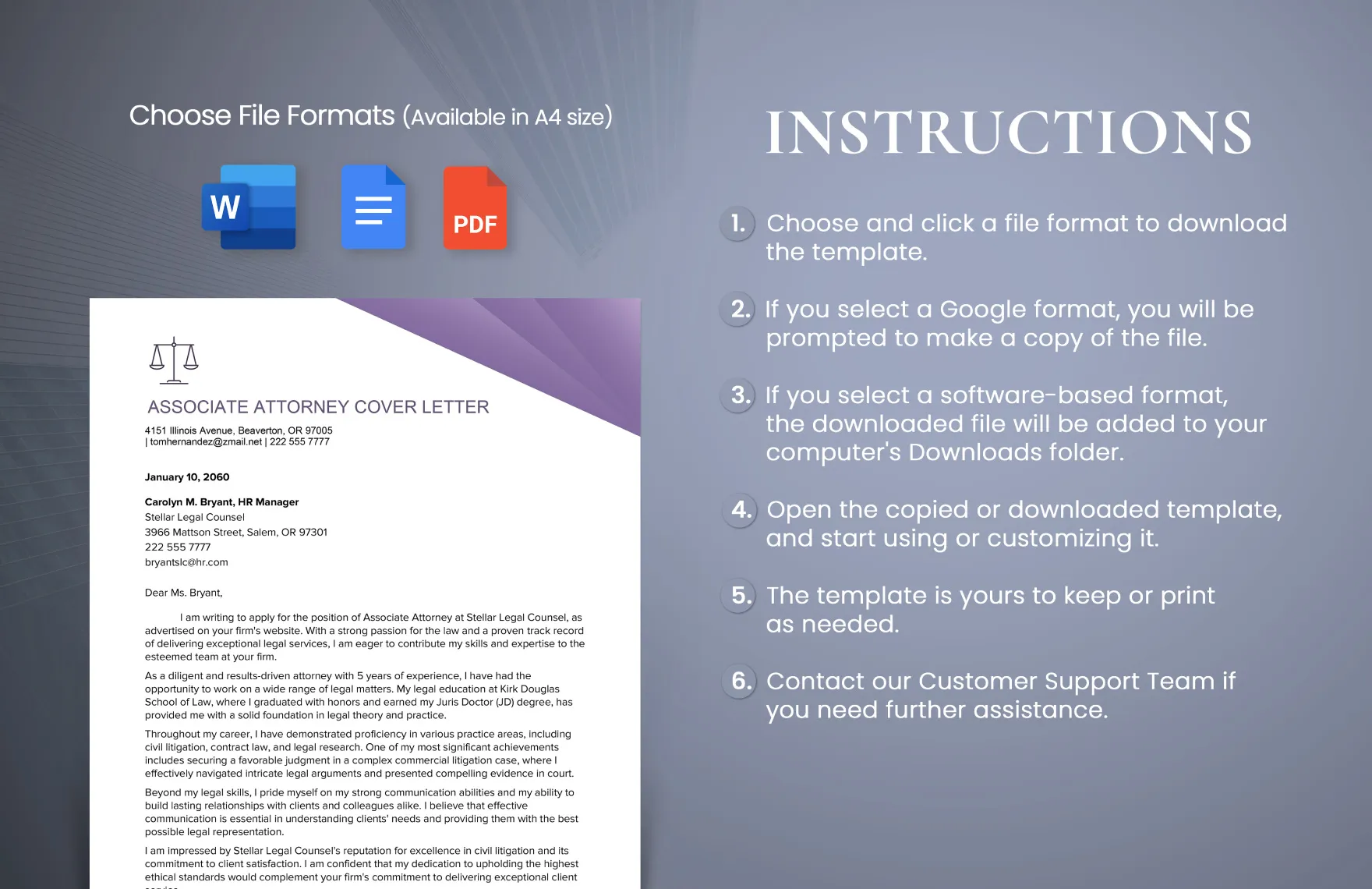
Formatting and proofreading are essential aspects of a successful law school cover letter. A well-formatted and error-free letter demonstrates your attention to detail and professionalism, which are highly valued in the legal field. These tips will help you ensure your cover letter is polished and presents you in the best possible light. Taking the time to format your letter correctly and meticulously proofread it can significantly impact your application. Attention to detail, good writing and formatting are crucial to making a positive impression.
Font and Layout
Choose a professional and easy-to-read font, such as Times New Roman, Arial, or Calibri, and use a font size of 11 or 12 points. Keep the layout clean and organized, with consistent margins (typically 1 inch on all sides). Use single-spacing within paragraphs and double-spacing between paragraphs. Use headings and subheadings to break up large blocks of text and make your letter easier to read. Ensure that your name and contact information are clearly displayed at the top, and that the date and recipient’s information are formatted correctly. Use a professional tone, avoiding slang or overly casual language. The layout should be visually appealing and easy to follow, enhancing readability and making your letter more approachable to the admissions committee. A well-formatted letter shows that you respect the reader’s time and that you are detail-oriented.
Proofreading Checklist
Proofreading is an essential step to ensure your cover letter is free of errors. Before submitting, carefully review your letter for any grammatical errors, spelling mistakes, punctuation issues, and typos. Check for proper sentence structure and ensure your writing is clear and concise. Have a friend, family member, or career counselor review your letter for a fresh perspective. They may catch errors that you have overlooked. Use spell-check and grammar-check tools, but do not rely on them entirely. Read your letter aloud to catch any awkward phrasing or inconsistencies. Make sure your letter is tailored to the specific law school and that it accurately reflects your experiences, skills, and interests. Proofreading can significantly improve your chances of success.
Sample Cover Letter for Law School
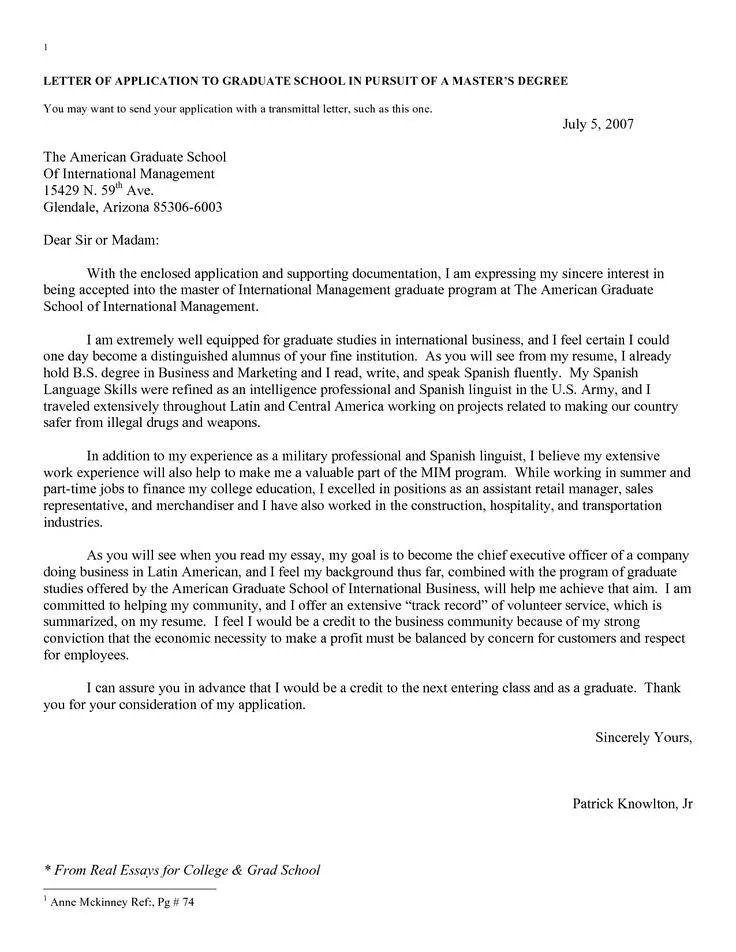
While it’s important to write a unique cover letter, reviewing a sample cover letter can be a helpful starting point. Sample cover letters can give you an idea of the format, tone, and content that are typically used in law school applications. However, remember to customize the sample cover letter to reflect your personal experiences, skills, and aspirations. Personalizing your letter is key to standing out and making a genuine connection with the admissions committee. Use the sample as a template, but adapt it to tell your story, highlighting your unique qualifications and demonstrating your genuine interest in the law school. This approach ensures your cover letter is both informative and authentic, increasing your chances of making a positive impression.
